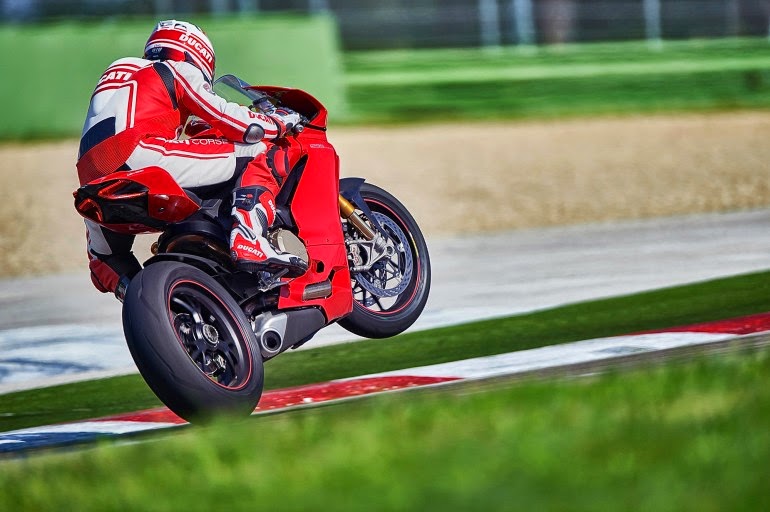The new Multistrada revealed at the
EICMA show in Milan
might be the most sophisticated and advanced bike in Ducati’s lineup.
Styling has been revised with new graphics, but that pales in comparison
to the significant evolutionary changes that have taken place with its
Testastretta engine.
That’s right; the new Multistrada is the first
Ducati
with latest evolution of the Testastretta 1,198 V-twin, which now
features the revolutionary Desmodromic Variable Timing (DVT) in
combination with dual-spark ignition and secondary air bleed. This bumps
claimed horsepower from 150 hp at 9,250 rpm to 160 at 9,500, and
claimed peak torque has increased from 91.8 pound-feet at 7,500 rpm to
100.3 at the same rpm. Simply put, there is no comparison between old
and new engines. The new Testastretta 1,198 DVT powerplant has a much
broader power curve starting as low as 2,000 rpm.
The superior performance is also related to upgraded electronics.
Ducati’s new electronics suite includes the Inertia Measurement Unit
(IMU), which has all features from before (traction control, ABS,
four-mode ride-by-wire) plus wheelie control. It also manages the latest
Ducati Skyhook suspension, which is standard on the Multistrada S. This
electronically managed semi-active suspension, by Sachs, features an
inverted 48mm fork and a single shock. The IMU also manages the latest
Bosch Cornering ABS, which prevents the Brembo brakes from locking a
wheel even when well leaned over.

Ducati’s base Multistrada has a non-adjustable 48mm inverted fork,
plus a pair of 320mm front brake rotors by Brembo. The Multistrada S,
with its electronically managed semi-active fork, gets 330mm front brake
rotors and the latest Brembo M50 calipers. Of note, the S also has a
full-color TFT dash, and the load settings of the Skyhook suspension are
adjustable at rest or on the fly, as are the four riding modes: Sport,
Touring, Urban, Enduro.
The new Multistrada S ($19,695) also benefits from a new full-LED
headlight with corner-lighting technology. Additional peripheral
lighting for the Multistrada S is available via a switch near the left
grip that actuates two additional lights. All Multistradas roll on
17-inch wheels shod with the latest Pirelli Scorpion Trail II, in
120/70-17 front and 190/55-17 rear sizes. In Europe, Ducati will
continue to offer the Multistrada S D/Air model, which features a
wireless connection to the airbag-equipped Ducati D/Air riding apparel
by Dainese.
If you’re one of those folks who plans to occasionally venture off
road on your Multistrada, the Enduro Pack accessory includes engine
crashbars, a radiator guard, an extended skid plate, auxiliary LED
lights, and off-road footpegs.
DVT 101
Ducati’s Testastretta engine has benefited from twin-spark ignition and
the development of the 11° version. That refers to the amount of valve
overlap in crankshaft degrees. Overlap is that period when the inlet
valves are open and the exhausts haven’t closed.
This overlap exploits the depression created in the cylinder by the
scavenging effect of the spent gases rushing out through the exhaust
port. Via fluid dynamics inertia, the volumetric efficiency of the
engine is pushed past 1:1. In other words, the inhaled charge exceeds
the swept volume of the cylinder. Problem is, at low rpm, the scavenging
effect is marginal, so little or no benefit at all comes from the
overlap phase. Since the timing remains unchanged, there is more time
for the fresh charge to be jettisoned through the exhaust, and the low
flow speed does not create the correct turbulence in the compressed
charge. Consequently, combustion is far from optimal. To address this,
Ducati has developed a full variable valve-timing system for the 11°
Testastrettra engine, the first of its kind applied to a motorcycle
engine or any powerplant with desmodromically operated valves.
Mechanically, the Desmo Variable Timing (DVT) system consists of an
external housing rigidly connected to the cam belt pulley, plus an
internal mechanism connected to the camshaft that rotates independently
inside the housing. This rotation of the internal mechanism of each
camshaft—advance or retard—is precisely managed by electronically
controlled valves that modulate oil pressure on either side of a
three-vane rotor sealed inside the chamber of the mechanism and solid
with the internal mechanism of the camshaft. The timing of each cam is
dynamically controlled by a sensor located in the cam covers and
continuously modulated based on factors sensed by the ECU, with engine
rpm and throttle position most important. More significant is its
effect. According to Ducati, the new 1,198 DVT twin generates 100
pound-feet of torque at 7,500 rpm and 160 hp at 9,500. The torque curve
is very broad, with 59 pound-feet on tap at just 3,500 rpm.
Compared to a standard 11° engine, the DVT version has 15 percent
more torque, with improved combustion stability and smoothness,
increased fuel efficiency and reduced emissions. Exact timing numbers
haven’t been released, but the variation is likely in the range of about
30 degrees, starting with “negative” overlap at lower rpm. By this, I
mean no overlap at all but rather a delay between the closing of the
exhaust valves and the opening of the inlets. This means no fresh charge
goes out the exhaust, combustion is improved at low rpm, and there’s no
more “Ducati shudder” when opening the throttle below 3,000 rpm.
DVT is revolutionary because overlap is crucial in achieving higher
performance. It’s no longer the old “torque versus power” quarrel; now
it’s torque
and power, with superior efficiency.
| BY THE NUMBERS |
|---|
| |
2015 Ducati Multistrada 1200 |
| BASE PRICE |
$17,695 |
| CLAIMED DRY WEIGHT |
511 lb. |
| WHEELBASE |
60.2 in. |
| CLAIMED HORSEPOWER |
160 hp @ 9,500 rpm |
| CLAIMED TORQUE |
100.3 lb.-ft. @ 7,500 rpm |
| RAKE/TRAIL |
24.0º/4.3 in. |





































